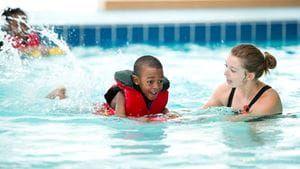
A Google search of the term ‘dry drowning’ turns up tens of thousands of results talking about the dangers of a person choking to death on water minutes or even hours after coming out of the water.
However, health experts say the number of people who experience dry drowning is very low – and the focus on this issue is overshadowing a bigger problem: drowning.
So what is the difference between drowning and so-called dry drowning? We asked Rochester Regional Health pediatrician Amanda Lloyd, MD, to explain and offer advice about being safe around water.
When a person’s face and nose are submerged in water for an extended time, they are unable to breathe and begin to aspirate water. This is called drowning. Drowning happens in shallow and deep water alike; infants and toddlers can drown in as little as 1-2 inches of water. Approximately 4,000 people in the U.S. die from drowning each year.
What is colloquially referred to as dry drowning or secondary drowning happens when a person begins to aspirate on water and comes back above the surface of the water. The vast majority of people are able to recover physically within a few minutes.
Some sustained symptoms that would require medical attention in that short window of time would be:
In extremely rare cases, someone may develop a laryngospasm – a condition in which the vocal cords seize and temporarily stop airflow into the lungs. These spasms last no more than 60 seconds.
The phrases ‘dry drowning’ or ‘secondary drowning’ are not actual medical terms. Medical experts say there has never been a case published in medical literature in which a patient was clinically evaluated and found to have no symptoms, only to rapidly decline and die more than 8 hours after the incident.
“If a child coughed or sputtered briefly while swimming, they are likely fine,” Dr. Lloyd said. “If they struggled underwater and continue to experience serious respiratory symptoms for more than a few minutes after breathing – not swallowing – water into their airway, parents should seek medical care.”
Drowning is often silent and not as obvious as portrayed in movies and TV shows. Everyone spending time near a pool, lake, or other body of water should take precautions to ensure their own safety, as well as those around them.
Supervise small children: More children ages 1-4 die from drowning than any other cause, according to the CDC. Paying attention to where young children are around water is vital to their safety. Setting down cell phones and other distractions allow parents and caregivers to stay within arms’ reach of little ones.
Enclose swimming areas: Pools are required to be enclosed with a fenced or gated-in area with a latching door in New York. This lessens the chances that a young child will wander into a pool while unsupervised.
Wear floatation devices: People of all ages should feel free to wear life jackets or other floatation devices around water if they are not strong swimmers. These help to reduce the risk of drowning for everyone who wears them.
Swimming lessons: Learning how to swim – and swim well – is one of the best things that parents and caregivers can do to help their children be safe around water. The American Academy of Pediatrics recommends children as young as 1 start swimming lessons to become comfortable around water and learn water safety skills.
Learn CPR: Taking advantage of infant and adult CPR classes is helpful in case of an emergency. Even if someone who is not your own child is in respiratory distress, these skills can save lives.
“Taking the right precautions around the water and paying active attention to the people you are with – especially children – goes a long way to preventing not only drowning but other potential injuries,” Dr. Lloyd said. “Spending time in pools and natural bodies of water is a great way to make memories and have fun. It’s important for everyone to be safe while doing so.”
